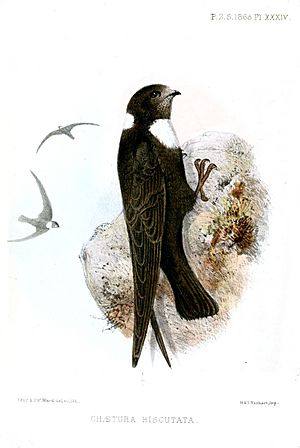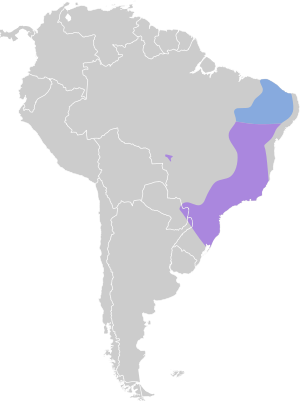Biscutate swift facts for kids
Quick facts for kids Biscutate swift |
|
|---|---|
 |
|
| Conservation status | |
| Scientific classification | |
| Genus: |
Streptoprocne
|
| Species: |
biscutata
|
 |
|
The biscutate swift (Streptoprocne biscutata) is a type of bird that belongs to the swift family. You can find this bird in Argentina, Brazil, and possibly Paraguay.
Contents
About This Bird
The biscutate swift has two main types, called subspecies. They are S. b. biscutata and S. b. seridoensis. Think of them like different breeds of a dog; they are the same species but have slight differences.
What Does It Look Like?
The biscutate swift is about 22 cm (8.7 in) long. It weighs around 115 g (4.1 oz), which is about the same as a small apple. Both male and female swifts look alike.
Adults of the main subspecies have a dark, sooty brown head. Their forehead, chin, and the area around their eyes are a bit lighter. Their body is a very dark, blackish-brown. They have a wide white band across their chest. There's also a thin white band on the back of their neck and a little on the sides. These white bands do not connect.
Their wing and tail feathers are blackish on the outside. The inside parts are a pale gray-brown. Young biscutate swifts look a lot like the adults. They have grayish-white edges on their belly feathers and on the tips of their tails. The S. b. seridoensis subspecies looks similar but is a bit smaller.
Where Does It Live?
The main subspecies of the biscutate swift, S. b. biscutata, lives in southeastern Brazil. It can be found from Minas Gerais all the way into Argentina's Misiones Province. Some people think it might also live in Paraguay, but this is not fully confirmed.
The S. b. seridoensis subspecies lives further north in Brazil. We don't know its full range yet. It has been seen in areas like Piauí and Rio Grande do Norte, going south into Bahia.
How Does It Behave?
Does It Migrate?
The biscutate swift stays in southern Brazil all year round. However, in the far northern parts of its range, it only appears during the cooler months, from February to October. We don't know where these birds go to breed.
This swift lives in many different places. It can be found in forests on mountains and in lowlands. It also lives in temperate forests and tropical forests where trees lose their leaves. Sometimes, it even lives in more open areas like scrublands.
What Does It Eat?
Like all swifts, the biscutate swift catches insects while flying. It usually hunts in groups with other biscutate swifts. Sometimes, it might even join white-collared swifts to find food. We don't know exactly what insects it eats. But we think it eats many different kinds, just like other swifts in its family.
How Does It Raise Its Young?
Biscutate swifts build their nests together in caves. They make their nests from things like lichen, moss, other plant parts, and soil. They usually place their nests on a ledge or stick them to a cave wall.
A female swift lays one to four eggs. Both parents take turns sitting on the eggs to keep them warm. They also both help take care of the baby birds. The eggs hatch after about 24 days. The young birds are ready to fly about 33 days after they hatch.
What Does It Sound Like?
The main sound the biscutate swift makes is described as "chee chee chee chee chee..." or "weep-weep-weep".
Is It Endangered?
The IUCN (International Union for Conservation of Nature) says the biscutate swift is a species of "Least Concern." This means it's not currently in danger of disappearing. It lives across a large area. However, we don't know how many biscutate swifts there are, and their numbers might be going down.
No big threats have been found for this bird yet. People haven't seen direct harm from human activities. But there are some possible dangers. These include hitting power lines, getting sick from pesticides, and changes in insect numbers due to climate change.
See also
 In Spanish: Vencejo nuquiblanco brasileño para niños
In Spanish: Vencejo nuquiblanco brasileño para niños


